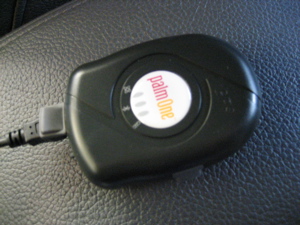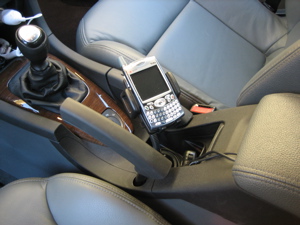Why in the World Did I Buy This?
 They say patience is a virtue, but it's never been one of my strong suits. Every time I got behind the wheel of my new car, I'd feel... empty. As empty as the spot on my dashboard where the flashy GPS nav unit had been in the fully loaded model I test drove.
They say patience is a virtue, but it's never been one of my strong suits. Every time I got behind the wheel of my new car, I'd feel... empty. As empty as the spot on my dashboard where the flashy GPS nav unit had been in the fully loaded model I test drove.
It was the kind of emptiness that could only by filled by purchasing expensive electronics. So, last Tuesday night, I stopped by the Palm store at the Stanford Mall and bought the Palm GPS Navigator for my Treo. And, even as my wallet felt emptier, my heart was full of joy.
Do I really need a GPS unit? You might as well ask Sonny the cuckoo bird if he really needs his Cocoa Puffs. Sure, my commute is three miles, I don't do a lot of driving in unfamiliar areas, and I'm fairly accomplished with both traditional and Internet maps. But electronics shopping isn't about need, dammit! It's about aching, lustful desire—the kind that makes men collect expensive cars or drink 30-year-old scotch or invade nations under false pretenses in pursuit of fossil fuels. Mmmmmm... gadgets!
What in the World is It?
 If you don't know what GPS technology is, go here for a much better explanation than I'm capable of. The Palm GPS Navigator is a small receiver unit about the size of a car alarm remote. Unlike other GPS units with their own interfaces and screens, it uses Bluetooth wireless technology to display information on a PDA or Smartphone... like my Treo 650. This means that it's significantly cheaper than self-contained units like the TomTom Go or Garmin StreetPilot. Plus, digital convergence is so damned sexy: Try calling your bookie or text messaging Elvis from your StreetPilot!
If you don't know what GPS technology is, go here for a much better explanation than I'm capable of. The Palm GPS Navigator is a small receiver unit about the size of a car alarm remote. Unlike other GPS units with their own interfaces and screens, it uses Bluetooth wireless technology to display information on a PDA or Smartphone... like my Treo 650. This means that it's significantly cheaper than self-contained units like the TomTom Go or Garmin StreetPilot. Plus, digital convergence is so damned sexy: Try calling your bookie or text messaging Elvis from your StreetPilot!
Another thing that appealed to me is that the Palm GPS Navigator comes with the same cool software that TomTom ships with its own GPS units, but costs $50 less than TomTom's Palm product. Plus it includes some useful accessories that TomTom doesn't provide: A car cradle and a dual charger with connections for both the GPS unit and the Treo. Finally, I knew my dad had just ordered the TomTom product, so this seemed like a good opportunity to compare gadgets with the man whose genes were responsible for my technophilia.
How in the World Does It Work?
 I'd read lots of reports online about problems setting up the TomTom unit with a Mac. I took a gamble that the Palm documentation and installer might be newer or more accurate than what TomTom ships, and it turns out I was right. I installed the software, voice, and maps exactly as shown in the manual, without downloading any updates, and everything worked like a charm.
I'd read lots of reports online about problems setting up the TomTom unit with a Mac. I took a gamble that the Palm documentation and installer might be newer or more accurate than what TomTom ships, and it turns out I was right. I installed the software, voice, and maps exactly as shown in the manual, without downloading any updates, and everything worked like a charm.
I even found a good place in my car to install the cradle. My new Saab has a second electrical outlet (no one calls them cigarette lighters anymore!) in a storage compartment under the armrest between the front seats. And there's a cupholder recess right in front of that compartment which is almost exactly the same size as the suction cup mount for the cradle—with just enough room left for the GPS unit to fit with a clear line of sight to the windshield. The only downside to this arrangement is that it can be a bit tricky to get the key in and out of the ignition. But the overall effect is much more elegant than trailing cables up the dashboard.
So how well does it work? My experience with the Palm GPS Navigator has been mostly good. There are a few hassles: it can take 2-3 minutes (or longer) for the GPS unit to acquire satellite signals, I can't use my Bluetooth headset without resetting the Treo, and incoming phone calls interrupt the navigation software. But the "wow factor" of seeing my phone scroll 3D maps across the screen while I drive and hearing it give me turn-by-turn directions is pretty impressive.
Where in the World Can I Use It?
 The Palm GPS Navigator works well enough in my car, but today I discovered another application that makes full use of this gadget's portability: Geocaching. In case you don't have the time or inclination to click the link I just provided, Geocaching is an activity where you download GPS coordinates from the Internet and search for "treasure caches" that other GPS nerds have hidden in public places. Sometimes the treasure is just a logsheet to sign, other times it's a crappy knicknack you could find much more easily in a gumball machine—but where's the fun in that?
The Palm GPS Navigator works well enough in my car, but today I discovered another application that makes full use of this gadget's portability: Geocaching. In case you don't have the time or inclination to click the link I just provided, Geocaching is an activity where you download GPS coordinates from the Internet and search for "treasure caches" that other GPS nerds have hidden in public places. Sometimes the treasure is just a logsheet to sign, other times it's a crappy knicknack you could find much more easily in a gumball machine—but where's the fun in that?
The receiver is small enough to fit in my pocket (it still gets a decent satellite signal, even under a layer of denim) and works with a variety of other GPS software that handles off-road travel better than the TomTom Navigator. I tried several different programs and finally settled on the combination of CacheMate and CacheNav. Then I registered at geocaching.com and did a quick search for caches within 20 miles of my apartment. I was stunned to find hundreds of them! It kind of freaked me out to realize that these secret containers were hidden all over the place. I was skeptical about how much fun it would be trying to decipher latitude/longitude readings on my phone while looking for a film canister with a Danish troll doll in it, but decided to give it a whirl.
Guess what? Geocaching was a blast! It's like an easter egg hunt for grown-ups (if you can call your typical GPS-toting ubergeek a "grown-up"). There's something immensely satisfying about finding something hidden in a place where dozens or hundreds of people pass by every day. I bagged two caches in about three hours, got in 6-miles of exercise, and discovered that the Palm GPS Navigator is remarkably accurate. It's also well-suited for geocaching, since you can log on to the web to search for hints or find new caches. I'm looking forward to another excursion tomorrow.
Well, there you have it. The Palm GPS Navigator has satisfied my latest bout of technolust and helped me find a new hobby. In the immortal words of Ferris Bueller, "It is so choice. If you have the means, I highly recommend picking one up."